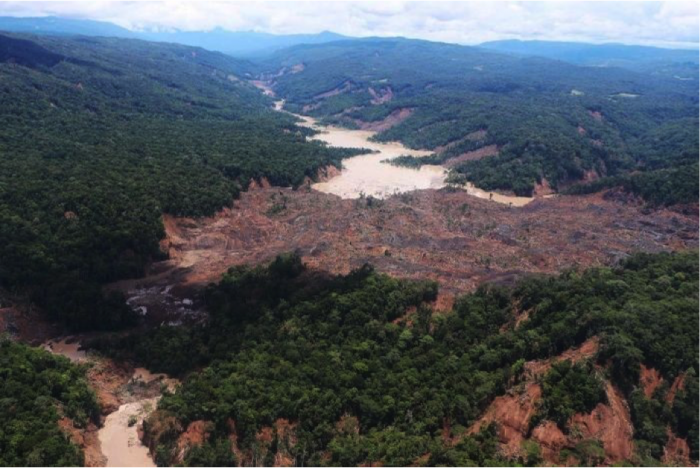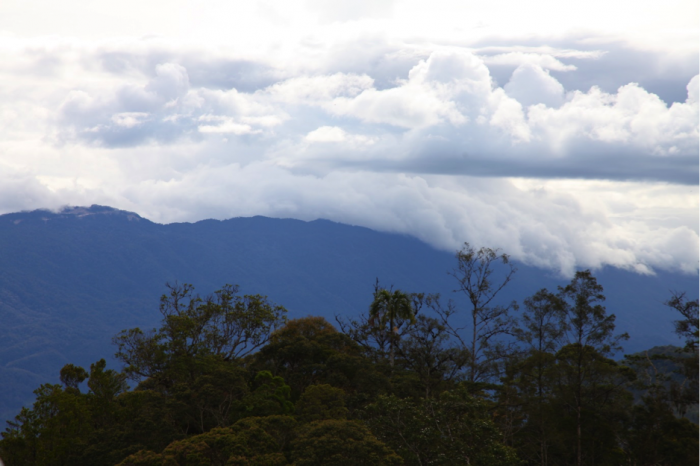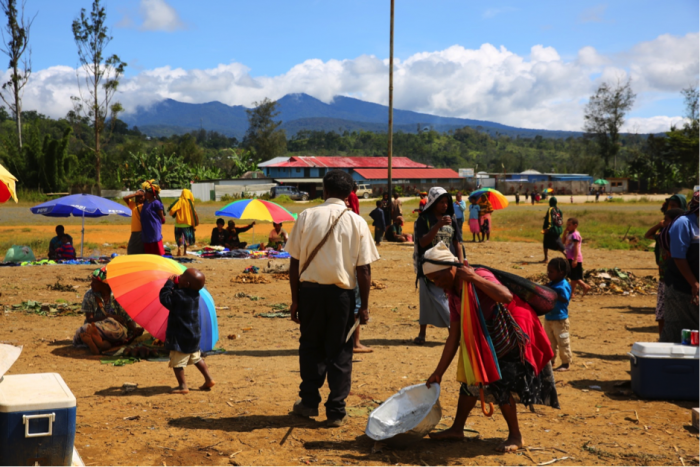The word for “earthquake” in the Huli language is wonderfully onomatopoeic: dindi dumbirumbi (literally “earth moving and shaking”). During fieldwork conducted in 2016, I interviewed an elderly Huli ritual leader named Dali Ango at his home in Koroba, located in Papua New Guinea’s (PNG) Hela Province. Huli ritual leaders, who inherited their position, were holders of a vast amount of traditional historical, genealogical, and cosmological knowledge. Ango talked of ancient land spirits (dama in Huli) named Hu and Hunabe, who, along with dindi dumbirumbi, formed the earth and the mountains. Earthquakes were just one of several indications that the earth was tending toward disaster. Earthquakes, droughts, floods, periods of famine, or even major warfare were held to be signs of impending doom that required the performance of large-scale dindi gamu (“earth spell”) rituals as a remedy (Ballard 1998: 73). In cultural terms, the most significant and influential seismic event that occurred in Huli history was the Plinian eruption of the Long Island volcano in the late seventeenth century (Blong 1982: 131). The resultant ash cloud that blanketed the landscape came to be known throughout Huli territory as mbingi, or “time of darkness.” The volcanic ash resulted in greatly increased fertility of the land and a period of abundant harvest for the years that followed. Mbingi was thought to be preceded by events such as earthquakes (which it quite likely was). Crucially, if people followed the correct procedures and behaviors during the event, then mbingi would result in a time of plenty. If social taboos were ignored and moral laws broken, then mbingi would be prolonged and all the crops would fail, and people would starve to death (Glasse 1995: 69).
Although these forms of knowledge have been largely forgotten, there is substantial evidence to suggest that seismic activity has been a major influence in Huli spiritual belief and practice. Before the recent and devastating magnitude 7.5 earthquake that struck Mount Sisa in Hela Province on 26 February this year, the last nearby earthquake in the order of magnitude 7 occurred near Tari, the largest Huli town, on 3 March 1954 (Ripperl and McCue 1983). The effects of this earthquake were recorded by missionaries and Australian government patrol officers who had established a permanent presence in Tari less than three years prior. A missionary with the Unevangelized Fields Mission wrote of the intensity of the earthquake and the disappearance of water from their well and the nearby spring (Twyman 1961). The aftershocks continued for months, and the impression this made on the Huli population was recorded in a patrol report conducted in October of the same year (Esdale 1954). The constant tremors were causing wide cracks in soft ground and Huli were noted to refer to dama spirits as being a cause.
A dominant motif of Huli spiritual belief and practice is the strange behavior of bodies of water. Lakes are said to disappear and move from one place to another. Lakes can rise up, and the movement of ripples is read in terms of good and bad omen. Hidden spirit lakes, with the names bume and deme (pertaining to the heart and the eye), are said to inhabit mountainous areas. After the Tumbi limestone quarry collapsed in 2014, killing more than a dozen people, the collapse was explained to me in terms of the blockage of bume and deme that was caused by ExxonMobil’s contractor, who constructed a road that blocked a stream emerging from the base of the quarry. The limestone karst system that dominates the Huli landscape has been instrumental in shaping these Huli beliefs and much of Huli mythology. Beneath this landscape can be found a complex network of underground rivers, sinkholes, and caves. Earthquakes can easily disrupt this system, causing instant changes to lake levels, and stream behavior. Major earthquakes do not usually occur as single events but are accompanied by a long period of aftershocks, as had been the case since 26 February this year, and recorded after March 1954. In 2016, I visited Tuandaga, a major Huli site of ritual significance, and one of the few still in use. At Tuandaga, as had been the case at ritual sites all across Huli territory, oblations are made of cooked pork for the appeasement of the dama spirit in the lake. The lake is said to rise up to meet the offering. Other rites involve throwing the offering into the water while the behavior of the ripples are observed. A certain type of rippling foretells of bad times for the fate of the land. Very large earthquakes that occur in this steep and brittle landscape can result in major landslides and the blockage of rivers, as is presently the case. At the time of writing, the Tagari River, which is the main river the runs through Huli territory, is dammed by a major landslide that is threatening a mudslide and flooding downstream once the unconsolidated dam is overflowed.
At Komo in 2016, just a few kilometers from the epicenter of the recent earthquake, I was told a Huli mythological tale about a man with no anus. A great feast was held, and the man with no anus just kept eating. His friend noticed that the man was unable to relieve himself and his belly was becoming bigger and bigger. So his friend built a house and inside he dug a hole in which he stuck a sharpened stick vertically into the ground. He covered up the hole with banana leaves and invited his friend inside to sit. When his friend sat on the sharpened stick, it pierced for him an anus, and when he pulled it out all his waste rushed out of him covering the whole place. This story, and versions of it, bears resemblance to the effect of a landslide that blocks a river, which is a not uncommon occurrence in the history of the Papua New Guinean highlands.

In the aftermath of the 26 February earthquake, the question that is dominating the minds of Huli residents is the role that the giant PNG LNG (Liquefied Natural Gas) project played in the earthquake’s cause. The PNG LNG project, constructed and operated by ExxonMobil, is the largest resource extraction project in PNG’s history and has been a source of intense anger for the vast majority of Huli landowners, who have yet to see any benefits from the extraction and sale of gas from their land. There is widespread belief that the earthquake was caused by gas extraction activities, which is an opinion that comes on top of an already existing resentment over the development failures of the project. This perception also extends to many of PNG’s politicians who requested that the Australian government provide an independent assessment of the earthquake’s cause. The perception of the earthquake’s cause is driven by a combination of scientific evidence and cosmological belief. The earthquake occurred along the Papuan Fold Belt in a region where earthquakes of magnitude 7 are predicted to occur approximately every 60 years (Ripperl and McCue 1983). The independent assessment provided by Geoscience Australia concluded that the earthquake was naturally occurring, yet this finding was disputed by the governor of Hela Province, who called for an independent review to be conducted according to the terms of the Hela Provincial government (The National 2018). Skepticism over the cause of the earthquake is supported by issues with gas extraction projects in various parts of the world, particularly in relation to newer technologies and the increase in the use of fracking (Kuchment 2016). Recognizing this, the managing director of Oil Search, Peter Botton, responded that this perception should be treated as “a communications issue” (Barrett and Gloystein 2018).
Resentment toward the PNG LNG project, which has intersected with the horror and trauma experienced by the recent earthquake, is not a communications issue. It is a development issue. Huli cosmological belief that the extraction of their gas will bring about the end of the world has been fueled over the past four years by growing resentment over the failure of the project to come good on its development promises. Last month’s devastating earthquake only provides confirmation of a widely held prophetic belief in the disaster that will befall the Huli population should they give away their gas. Gas for the PNG LNG project is extracted from a mountain ridge named Hides Ridge after the early Australian explorer Jack Hides. The Huli name for this mountain is Gigira. Moist air that rises over Gigira tends to form clouds that give the appearance of smoke oozing from the ridge, similar to the smoke from a traditional kunai grass-roofed house with a fire inside. This visual effect provides the basis for the belief that there is a fire burning underneath Mount Gigira. A giant log of hardwood commonly used in fireplaces, a type of tree known in Huli as lai, is said to run the length of the Gigira range. One day, the ancestors said, a man with red legs will come to take the fire. You may give him some of the fire, but do not give away all the fire lest the world will end. When ExxonMobil began to drill for gas on Mount Gigira, local residents packed up and left in the fear that the fire would spill out from the mountain and engulf them. In the absence of development benefits from the PNG LNG project, one thing is clear: the landowners have given away all their fire.

Earthquakes, which were once understood in the context of a complex set of intersecting beliefs, are now attributed to a single cause that has come to dominate the Huli landscape both physically and cosmologically. The old knowledge and practices have long been abandoned, and a space for new interpretations based on contemporary realities has opened up. The PNG LNG project, with its promise of abundant wealth yet delivery of disaster and neglect, has become the new mbingi. Before the earthquake, there were mounting threats being made against the project, including an armed blockade in August 2016. These threats are a direct result of the development failures of the project, such that it has become in the best interests of the landowners to shut the project down in the hope that a change in development outcomes can be forced. With the PNG LNG project currently in forced shut down because of the damage caused by the earthquake, it is in the landowners’ best interest to blame the earthquake on the project. A PNG LNG project that had kept its promises would have been viewed favorably by a population that might be turning its attention to the challenges of developing the highlands in the context of life in an earthquake zone.
In 1954, the missionaries at Tari watched their newly built houses collapse around them while the local bush material houses would “sway with the earthwaves like a tree in the wind” (Tomassetti 1997: 65). The highlands missionaries were later required to build their houses according to New Zealand Earthquake Standards (Wood and Reeson 1987: 75). The extent of suffering in this most recent major earthquake is partly because of the amount of built infrastructure that has collapsed, none of which existed in 1954. If the PNG LNG project had delivered on its promises of education and training opportunities, infrastructure, business development, and alleviation of poverty, then the concern of its Huli landowners might be over how to utilize their resource to better develop their province to cope with earthquakes into the future. As it is, the PNG LNG project is logically understood in the context of their resource curse. If the proponents of the PNG LNG project had a better understanding of these dynamics, then they might be prompted to do something about it. Communications issue indeed.

Michael Main is a PhD candidate in the School of Culture, History and Language at the Australian National University. Michael’s research is focused on Huli society and culture in Papua New Guinea’s Hela Province, as well as the rapid changes that have been unfolding since the colonial period of the 1950s, culminating in the construction of ExxonMobil’s giant PNG LNG project.
References
Ballard, Chris. 1998. “The Sun by Night: Huli Moral Topography and Myths in a Time of Darkness.” In Fluid Ontologies: Myth, Ritual and Philosophy in the Highlands of Papua New Guinea, ed. Laurence R. Goldman and Chris Ballard, 67–86. Westport, CT: Bergin & Garvey.
Barrett, Jonathan, and Henning Gloystein. 2018. “Shakes and Superstition: Exxon Faces Backlash in Papua New Guinea.” Reuters, 7 March https://www.reuters.com/article/us-papua-quake-exxon-insight/shakes-and-superstition-exxon-faces-backlash-in-papua-new-guinea-idUSKCN1GJ12S.
Blong, Russell J. 1982. The Time of Darkness: Local Legends and Volcanic Reality in Papua New Guinea. Canberra: Australian National University Press.
Esdale, F. V. 1954. Tari Patrol Report No. 2 of 1954/55. Retrieved from Patrol Reports [microform]. Port Moresby: National Archives of Papua New Guinea:
Glasse, R. 1995. “Time Belong Mbingi: Religious Syncretismand the Pacification of the Huli.” In Papuan Borderlands, Huli, Duna, and Ipili Perspectives on the Papua New Guinea Highlands, ed. Aletta Biersack, 57–86. Ann Arbor: University of Michigan Press.
Kuchment, Anna. 2016. “Drilling for Earthquakes.” Scientific American, 28 March. https://www.scientificamerican.com/article/drilling-for-earthquakes.
Ripperl, I. D., and K. F. McCue. 1983. “The Seismic Zone of the Papuan Fold Belt.” BMR Journal of Australian Geology and Geophysics 8: 147–156.
The National. 2018. “Report: Earthquake Natural.” 20 March.
Tomassetti, Berard. 1997. Papua New Guinea Encore. Victoria, KS: St. Fidelis Friary.
Twyman, Eva. 1961. The Battle for the Bigwigs. Melbourne: Unevangelized Fields Mission.
Wood, A. Harold, and MargaretnReeson. 1987. A Bridge Is Built: A Story of the United Church in the Highlands of Papua New Guinea. Sydney: Commission for Mission Uniting Church in Australia.
Cite as: Main, Michael. 2018. “How PNG LNG Is Shaking Up the Earthquake.” EnviroSociety, 28 March. www.envirosociety.org/2018/03/michael-main-how-png-lng-is-shaking-up-the-earthquake.
